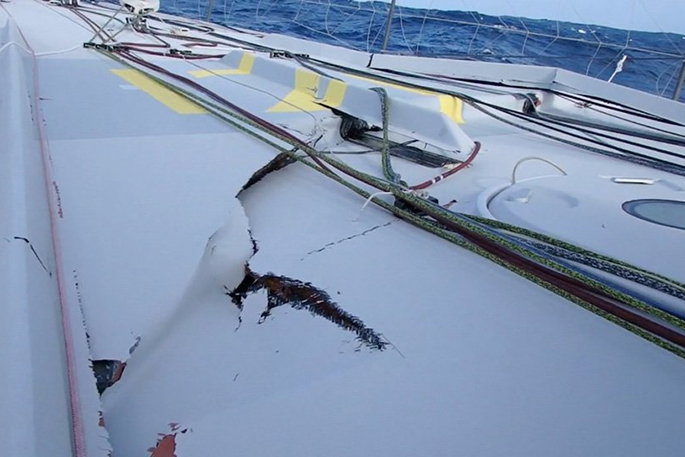The plight of a French skipper limping toward Bluff after striking what he believes was a shipping container in the Tasman Sea has lessons for local sailors, says Tauranga Coastguard training officer Donna Bennett.
The IMOCA Le Souffle de Nord arrived safely in Invercargill this morning after striking the object on Sunday, breaking open the hull. Thomas Ruyant says the 60ft (18m) yacht came to a sudden standstill while travelling at 17-18knots (about 30km/h).
'The whole of the forward section exploded and folded up,” says Thomas on Vendee Globe
'It was really very violent. I was sleeping on my beanbag and fortunately I had my head down in that, as I ended up hitting the mast bulkhead. I found things that were stowed in the stern right up against the forward bulkhead. They got thrown 10m forward.”
He says he's fortunate he wasn't dismasted. He retired from the race and as he got within 40nm [nautical miles] of Bluff, he picked up two sailors from a NZ Coastguard boat who brought an additional pump on board.

It's a timely reminder for Tauranga boaties, says Donna. Tauranga is a log port. There are also rivers in the Bay of Plenty that bring trees down to the sea.
'It's possible this sort of thing can happen to our local people,” says Donna.
'Just this morning we had a report of a tree in the water either in or just outside the harbour.”
There are things boaties can do before they head out, and the Souffle du Nord event is a good time to remind people.
There are a couple of acronyms. WET which stands for Weather, Equipment, and Tell someone. Check the weather forecasts. Make sure all the equipment on board is working. It's also a good idea to have a second means of propulsion, in case you do hit a log and the engine is taken out, says Donna.
And tell someone where you are going, and when you will be back.
If you do find you have hit something and the boat is taking on water there's another acronym for basic survival mode.
LIFES:
Lifejacket on, it's a time of heightened risk and it is mandatory.
Investigate what's happened, what damage is done.
Fix it, if you can or slow the leak down if possible. If you can still make way, head for shore, the closer to shore you are the better. Start bailing.
E is for emit. It is time to send a distress signal, a mayday call. VHF channel 16 and a 111 call if there's an operating cell pohone.
Stay with the boat. Don't try to swim to shore.
The rescuers can find a boat, even one that is swamped or capsized, for more easily than they can find a person in the water, says Donna.
'Always stay with the boat. A sinking boat doesn't always go straight down, there are often air pockets.”
And those on board are better off out of the water for hypothermic reasons, says Donna.



1 comment
Thanks Coastguard
Posted on 21-12-2016 17:59 | By Reefer
some good advice there going into the busy summer season. Hope plenty of local boaties are taking note and making sure they're well prepared. And join up to to coastguard. A great christmas present idea for anyone with boaties in the family.
Leave a Comment
You must be logged in to make a comment.